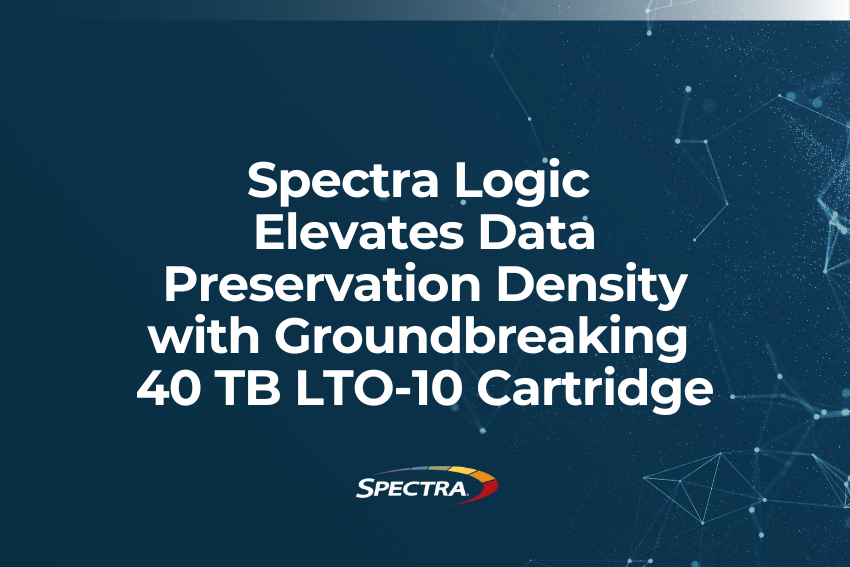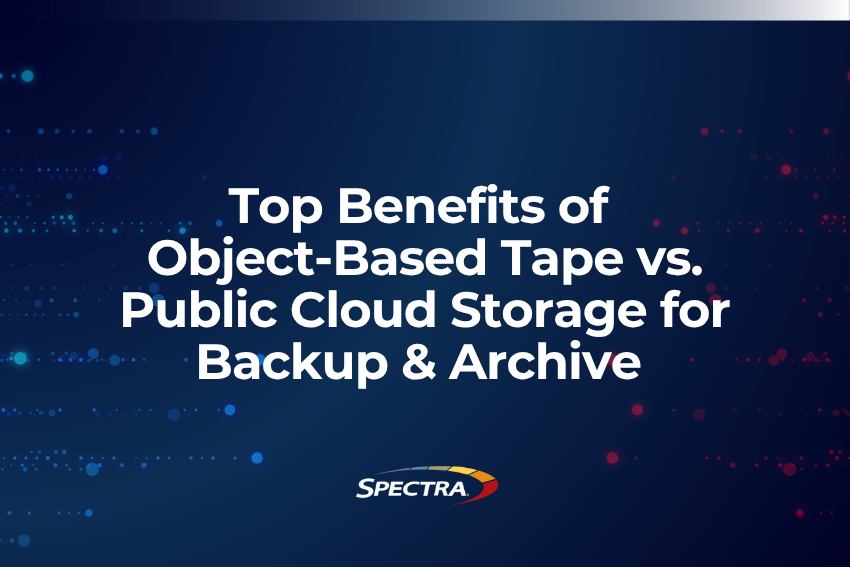
By Matt Ninesling
Director of Hardware Engineering, Spectra Logic
Learn how to align your tape-based backup and archive strategy with business needs and regulatory requirements.
On June 5, 2025, United Natural Foods Inc. (UNFI), one of North America’s largest healthy food distributors, discovered unusual activity within its IT systems. Unauthorized actors had gained access to the electronic infrastructure responsible for managing the company’s complex network of food ordering, processing, and distribution across the country. Although UNFI’s IT leaders acted quickly to contain the data breach, the cyberattack led to significant financial damage. The company estimated it lost between $350 to $400 million in net sales.
UNFI’s experience illustrates a crucial truth: from sensitive customer information to trade secrets to purchasing history, business runs on data. Lose control of it, and the economic — and in some cases, legal — consequences can be catastrophic.
To maintain business continuity, every enterprise must have a well-defined data protection strategy to safeguard its information.
In this article, you’ll learn how to evaluate your data protection needs so you can develop an optimal data security approach, plus tangible ways to ensure your organization never has to confront irreversible data loss.
Define Your Data Protection Requirements
Your data protection strategy hinges on understanding two core elements about your company’s information:
- What is the value of the data, and how is it operationally used?
- What risks or threats do you need to protect your data against?
The first question identifies the level of data availability you need. The second defines the specific technology and best practices to deliver that availability.
There are numerous techniques for dealing with real-time disaster recovery scenarios. These include synchronous copies between transaction systems, asynchronous copies at a distance, real-time erasure coding, and more.
These systems are designed to enable instantaneous or rapid recovery from disaster scenarios and focus on achieving specific recovery point and recovery time objectives. Additionally, high-availability topologies protect data against failures in the underlying storage technology, such as various forms of RAID.
Backup and archival data stored on tape requires a unique set of considerations.
Tape Storage: Reliable & Secure
Tape technology offers a level of reliability that significantly surpasses many other storage methods.
For instance, Linear Tape-Open (LTO) technology, such as LTO-9 and LTO-10, features:
- A significantly lower bit error rate than hard disk drives (HDDs). Tape is five orders of magnitude more reliable than HDD technology.
- A lifespan of up to 30 years, compared to the typical 3- to 5-year lifespan of HDD
- The ability to be stored offline, rendering it impervious to electronic incursions
Despite this inherent reliability, variables such as human error, environmental issues (i.e. cooling and humidity failures, contamination), and geographic disasters such as earthquakes and wildfires can still impact data availability.
For these reasons, data managers must architect solutions that align data value with cost, assurance, and dependability.
Data Value, Drivers & Business Needs
Businesses often use both backup and archive systems. When examining such options for your organization, it’s essential to first understand the function of your data. What is its business value — and what are the consequences if the data is lost?
We can group data function into five core categories:
Category 1: Business Policy
Data is archived because it is company policy, not because it is legally required or critical to business operations. Data can be reproduced or recovered by re-running an application.
Category 2: Essential Backup
Data is a backup copy of your business or application. It would be essential in recovery following a system error or disaster, such as a ransomware attack.
Category 3: Regulatory Requirements
Data must be archived to meet legal or regulatory requirements. If lost, the business could face substantive penalties.
Category 4: Financial Value
Data holds significant operational or financial value and would have a major impact if it were not available.
Category 5: Critical to Business
Data is critical to the business and must be protected from any security breach.
Once you identify which category your data falls into, you can build a strategic plan to protect your organization from irreversible data loss. This exercise also helps inform your data protection best practices — including whether you need one or two copies of data on tape:
- For Category 1: A single tape copy may suffice. Due to tape’s superior reliability and cost-effectiveness, it is an excellent fit. However, even the best storage method can’t protect a single copy from all risks (for example, if a wildfire claims a data center).
- For Categories 2–4: Redundancy is critical due to the high impact of data loss. To guard against uncorrelated technology failures, consider:
- One copy stored on an active system and one tape copy on a backup system.
- Or, a second tape copy stored either in a separate tape library or within a protected library partition for added security.
- For Category 5: The same protection as Categories 2-4, plus at least one copy is air gapped and immutable. Encrypt sensitive data to prevent it from being read if compromised.
To further strengthen resilience and protect from correlated errors, organizations should consider adopting a 3-2-1-1-0 strategy, a best-practice protocol which is especially useful for backup storage tiers:
- 3 copies of the data: one primary and two backup/archive copies
- 2 different technologies: such as any combination of flash, HDD, tape, and cloud
- 1 copy stored in a remote location for geographic and human error protection (explore how the University of Utah uses tape to protect research data against earthquake threat)
- 1 offline copy: ideally on tape for air-gapped protection
- 0 errors: use data integrity verification checks to ensure recoverability
| Data Category | Protection Scenario | Best Practice |
| 1: Business Policy | Data should be on robust infrastructure, but small losses of data are acceptable |
Data saved on modern LTO tape technology in an acceptable ambient environment. |
| 2: Essential Backup | Data should be highly protected from uncorrelated and correlated errors. |
Multiple copies of the data on any technology combination. Consider following the 3-2-1-1-0 backup strategy or make two copies on tape in either two libraries or in a protected library partition. |
| 3: Regulatory Requirements | Data should be highly protected from uncorrelated and correlated errors. |
Multiple copies of the data on any technology combination. Consider following the 3-2-1-1-0 backup strategy or make two copies on tape in either two libraries or in a protected library partition. |
| 4: Financial Value | Data should be highly protected from uncorrelated and correlated errors. |
Multiple copies of the data on any technology combination. Consider following the 3-2-1-1-0 backup strategy or make two copies on tape in either two libraries or in a protected library partition. |
| 5: Critical to Business | Data should be highly protected from uncorrelated and correlated errors. Add protection against external access breaches. |
Multiple copies of the data on any technology combination. Follow the 3-2-1-1-0 backup strategy or make two copies on tape in either two libraries or in a protected library partition. Have one offline, air-gapped copy that is also encrypted. |
Considerations in a Simple Tape Environment
In many cases, a reliable, straightforward backup and archive setup can be achieved using an on-premises tape library. Consider whether your protection needs can be met with either a single or dual copy on tape:
Use a “single tape” copy when:
- Additional copies are stored elsewhere (for example, on disk, flash, or cloud)
- The archived data is not operationally critical or required by regulation, and the risk of a single copy is acceptable
- Your organization has robust cybersecurity protection and you don’t require an air-gapped solution
Use a “dual tape” copy when:
- A second data copy is essential to your business
- Regulatory compliance requires a secure, secondary copy
- Data is not something that can be recreated, such as satellite or scientific data
- You need added air-gapped protection against ransomware or other cyber threats
The Importance of Ongoing Data Verification
Whether you choose a single or dual tape strategy, your approach should align with your organization’s data value, risk tolerance, and governance requirements to ensure data is reliably safeguarded.
Once a data protection method is in place, it’s essential to regularly monitor and verify data integrity. Many backup systems rely on an initial full copy with incremental updates over time, making that base copy critical. In the end, your data copies are only as strong as the original they’re built on.
Using regular Data Integrity Verification checks on data that is stored on tape can add a level of reassurance that the data in the backup or archive is safe and usable. Verify that your backup/archive software has this ability, or use similar functionality that is built into Spectra tape libraries and can be completed out-of-band from the software application.
Know Your Data, Protect it Right
A robust data protection strategy is essential to business continuity, and for many organizations, tape remains a reliable and cost-effective cornerstone.
However, determining whether one tape backup is enough depends on the value of the data and the risks associated with its loss. For low risk, reproducible data, a single tape copy may suffice. But for data tied to regulatory compliance, financial operations, or business-critical functions, redundancy is key.
Following best practices such as the 3-2-1-1-0 backup protocol can help enterprises avoid irreversible data loss. No matter the strategy, ongoing data verification is critical to ensure data remains intact and recoverable in perpetuity. Ultimately, aligning protection methods with data value, business needs, and risk tolerance enables organizations to safeguard their most important asset: their data.






